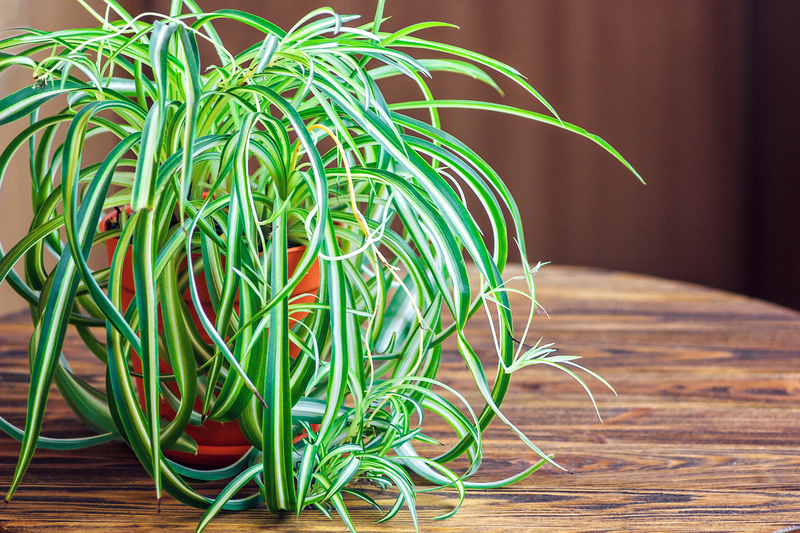Creating a Backyard Space that Encourages Exploration
Posted on 03/07/2025
Creating a Backyard Space that Encourages Exploration
Are you dreaming of a backyard that sparks curiosity and invites adventure? Whether for children, adults, or the entire family, creating a backyard space that encourages exploration transforms your outdoors into a world of discovery, learning, and lasting memories. This in-depth guide explores design principles, engaging features, and practical tips to help you craft an exciting, safe, and imaginative backyard haven.
Why an Exploratory Backyard Matters
Unlike basic lawns or bland patios, a thoughtfully designed exploratory backyard does more than visually please--it nurtures inquisitive minds, inspires creativity, and promotes healthy activity. From childhood development to adult relaxation, a space that encourages exploration can enhance well-being and make time outdoors more rewarding.
- Stimulates curiosity: New textures, sights, sounds, and smells invite endless discovery.
- Supports learning: Outdoor play teaches science, problem-solving, teamwork, and motor skills.
- Promotes activity: Walking, climbing, gardening, and games keep everyone moving.
- Reduces stress: Immersion in nature has been shown to alleviate anxiety and boost mood.
With those benefits in mind, creating a backyard space that encourages exploration becomes less about aesthetics and more about inviting adventure and discovery into your daily life.

Planning Your Exploratory Backyard Space
Assess Your Space
Start by evaluating your current backyard. How much space do you have available? What's the existing terrain like? Are there mature trees, shady corners, sunny spots, or changing elevations? Understanding your landscape's unique assets is the first step in creating a backyard that fosters exploration.
- Take note of natural features: Rocks, logs, slopes, and bushes already offer opportunities for play.
- Observe sun and shade patterns: This will influence plant choices and where you build features.
- Tune in to water flow: Rain patterns or existing water features can be incorporated into designs.
Set Goals for Exploration
Think about the ages, interests, and needs of your family or users. The ideal exploratory backyard space is personalized:
- Children: Climbing, digging, hiding, and messy play areas.
- Teens: Sports space, privacy nooks, and creative corners.
- Adults: Gardens, reading spots, meditation zones, or entertaining areas.
*Mix features to cater to different age groups and foster intergenerational exploration!*
Safety First
*Exploration shouldn't compromise safety.* Always assess your design from a safety standpoint. Use soft, impact-friendly surfaces for play zones, provide adequate shade, and keep fences or gates secure if children use the space. Remove sharp objects, toxic plants, or any hazardous debris.
Design Elements to Encourage Backyard Exploration
1. Diverse Plant Life and Sensory Gardens
One of the simplest ways to foster exploration outside is with varied, lush, and layered planting. A backyard that encourages exploration should tantalize all senses:
- Touch: Soft lamb's ear, spiky ornamental grasses, bumpy bark, velvety petals.
- Sight: Colorful annuals, unusual shapes or patterns, changing foliage through the seasons.
- Smell: Fragrant herbs (mint, lavender, rosemary), scented flowers, or aromatic foliage.
- Sound: Rustling bamboo, leaves in the wind, water features, chimes.
- Taste: Edible gardens with berries, veggies, herbs, or fruit trees (supervised with young kids).
Planting with diversity ensures there's always something new to notice and enjoy as seasons change!
2. Natural Play Features and Loose Parts Play
Move away from standard plastic playsets and incorporate natural elements which inspire imaginative play:
- Tree stumps and logs: Step, balance, create obstacle courses, or use as fairy tables.
- Boulders or rock piles: Climb, leap, or stack stones.
- Loose parts: Sticks, pinecones, bark pieces, leaves, or shells--kids naturally invent games.
- Sand or mud pit: Dig, build, sculpt, and explore tactile sensations.
- Willow tunnels or living forts: Twisting paths and hideaways spark endless pretend play.
Open-ended elements allow children (and adults!) to reimagine and repurpose the backyard environment every day.
3. Water Features for Interactive Play
Adding water transforms any backyard into a hub of sensory exploration:
- Streams or splash zones: Circulating pumps can create gently flowing water for wading or toy boats.
- Ponds: Watch frogs, snails, and dragonflies; learn about lifecycles and ecosystems.
- DIY rain gardens: Collect roof runoff in a planted depression. Kids watch as rain soaks in and plants thrive.
- Small basins and pumps: Simple container fountains invite hands-on splashing and experimentation.
*Always supervise young children around water features, and fence larger ponds for safety.*
4. Pathways, Mazes, and Secret Spaces
*Encouraging backyard exploration is as simple as creating interesting routes through your landscape!*
- Winding paths: Use flagstones, mulch, stepping stones, or turf. Paths beckon visitors to discover hidden areas.
- Living mazes: Shape hedges, tall grasses, or sunflowers into maze-like boundaries.
- Teepees, tents, and forts: Fabric, branches, or living structures (like runner beans on poles) offer secret escapes.
- Nature nooks: Designate corner spaces for bug hunts, "campouts," or reading.
These elements encourage kids to wander, peek, and invent games--while adults can enjoy peaceful retreats for reading or reflection.
5. Climbing, Balancing, and Movement Zones
Physical activity is a core part of any exploratory backyard experience. The most memorable spaces include:
- Climbing structures: Treehouses, rope ladders, climbing walls, or cargo nets blend adventure with fitness.
- Balance beams: Simple logs or installed beams challenge motor skills.
- Slacklines: Secure between trees for hours of wriggling fun.
- Leaf piles: Seasonal, but irresistible for running and jumping!
Modify features for age and skill. Keep landing areas soft with sand, mulch, or grass for added safety!
6. Engaging Wildlife Habitats
Inviting wildlife boosts curiosity. Consider:
- Birdhouses and feeders: Attract songbirds and teach patience and observation skills.
- Butterfly gardens: Plant milkweed, coneflower, and zinnias for pollinators.
- Bug hotels: Create shelters for beneficial insects in logs, brick piles, or stacked pallets.
- Small woodpiles: Shelter insects, toads, and reptiles for biology exploration.
*Observing the parade of visiting creatures adds another layer to your backyard's exploratory appeal!*
7. Edible Gardens for Tasting and Tending
A garden offers endless opportunities for exploration--from seed to harvest. Growing food together teaches about nature cycles, nutrition, and patience. Even a few containers can yield:
- Cherry tomatoes and peas for snacking
- Strawberries or blueberries for sweet treats
- Scented herbs for touch and taste (mint, basil, thyme)
- Rainbow carrots or purple beans for visual thrill
Involve your children in the gardening process; they'll love eating what they've helped to grow.
Innovative Backyard Exploration Ideas by Age Group
Exploration Ideas for Toddlers & Preschoolers
- Mini digging pits and mud kitchens
- Bubbles, wind chimes, and musical walls
- Simple stepping-stone paths
- Peekaboo spaces (tunnels, hideouts, large leafy plants)
Adventurous Backyard Spaces for Older Kids
- Treehouses, ziplines, or rope bridges
- Obstacle courses and scavenger hunts
- Science corners (weather station, bug habitat, rock collections)
- Creative outdoor art stations (chalkboards, easels, mud painting walls)
Creative Ideas for Adults and All Ages
- Zen gardens and meditation benches
- Outdoor kitchens and pizza ovens
- Potting sheds and craft tables
- Outdoor movie nights or astronomy areas
Making Your Backyard Exploration Space Functional and Sustainable
Low-Maintenance and Eco-Friendly Tips
- Choose native plants: They require less water and attract local wildlife.
- Use permeable surfaces: Mulch, pea gravel, and groundcovers help rainwater soak in.
- Compost on-site: Use kitchen scraps and yard clippings for nutrient cycling and soil health.
- Opt for natural materials: Wood, stone, and bamboo blend seamlessly and are safer for kids.
- Solar lighting: Sustainable, easy to install, and extends discovery into the evenings.
Maintenance for Year-Round Exploration
- Clear debris regularly for safe play.
- Prune plants and trees for visibility and sun/shade balance.
- Repair or refresh play features each season.
- Rotate loose parts and play items to keep interest high.
A well-maintained yard ensures continuous discovery and peace of mind for you and your family!
Final Tips: Fostering Exploration for All
- Invite input and ideas from those who use the space. Get kids' suggestions or ask guests what adventures they'd love next.
- Change things up regularly: Add new loose parts, replant, or rearrange paths each year for surprise and delight.
- Mix grown-up and kid-friendly spaces: Exploratory design isn't just for children--everyone can enjoy playful elements like swings, hammocks, or quiet garden nooks.
- Be flexible and allow for wildness: Leave some areas "untamed" for the joy of unplanned exploration, bug hunts, or impromptu forts.
By making intentional design choices and focusing on a multi-sensory, ever-changing environment, you can easily create a backyard space that truly encourages exploration. Such a space becomes a living extension of your home--offering joy, comfort, adventure, and endless learning for years to come.

Frequently Asked Questions about Exploratory Backyards
How do you encourage kids to spend more time outdoors?
Make the outdoors inviting and "hands-on"--loose parts, climbing features, bug hunts, and ever-changing play areas foster a natural urge to explore. Keep screens indoors during outside time, and model curiosity by joining in the play.
What are cost-effective ways to create an exploratory backyard?
Use what you have: Logs, rocks, mulch, and native plants are inexpensive and provide rich exploratory value. DIY features (palette teepees, recycled stepping stones, homemade bug hotels) stretch budgets and personalize your space.
How can I make my backyard appealing year-round?
Plant for multi-season interest--choose evergreens, ornamental grasses, and bulbs. Rotate play items, set up sheltered spaces, and include areas for winter birdwatching or snow fort building to ensure there's always something new every season.
Start Creating Your Backyard Space that Encourages Exploration Today!
Whether you have a sprawling garden or a cozy courtyard, it's always possible to create a backyard space that encourages exploration. Let your imagination lead and watch as your landscape grows into a wonderland of discovery, adventure, and beauty.
Ready to get started? Share your backyard exploration plans in the comments below or contact us for more tips!

